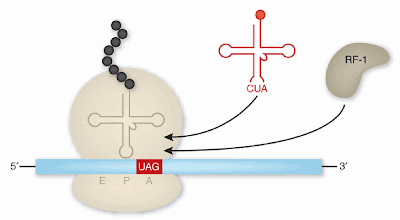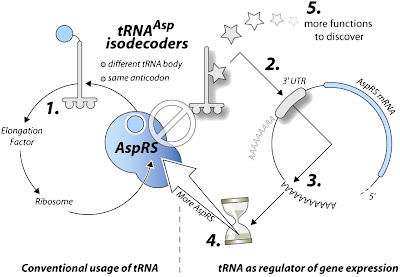Biology concepts – DNA, RNA, tRNA, nonstandard nucleotides, codon, anticodon, genetic code, selenocysteine, isodecoder, mitochondria
The first edition of Lincoln Logs, sold in 1918, gave instructions for building Abraham Lincoln’s boyhood home and Uncle Tom’s cabin. The parts were commensurate for building those structures. Each set of instructions called for the small pieces to be put together in a certain order so that the resulting product conferred a meaning – this is where Lincoln grew up or this is where Tom lived.
DNA and RNA are similarly constructed. There are a few pieces (nucleotides A, C, G, T, and U) that can be used to build different structures. Each small piece can be joined with other small pieces to become part of the whole structure, a structure with meaning. In the case of DNA and mRNA, three nucleotides in a row can confer meaning for one protein building block. The entire series of nucleotides then has the meaning of an entire protein.
The three nucleotide codons relate to a certain amino acid building block to be inserted into a growing protein. This code, the genetic code, gives meaning to the string of DNA nucleotides in genes and the string of nucleotides in the mRNA transcribed from the gene. This is usually where our learning about nucleic acids ends.
But I digress – let’s talk briefly how we decoded the pathway of gene to protein. It begins with Watson and Crick publishing the structure of DNA in 1953. We knew how the different bases could be ordered, but we still didn’t know how they called for a specific amino acid sequence.
In 1955, Francis Crick thought he had an idea about how it might occur, but he didn’t have all the players. He called his idea the Adapter Hypothesis. What he was missing was the adapter, the piece that he said carried amino acids and put them in the correct order.
One neat trick came from George Gamow, a nuclear physicist best known for his role in theorizing the Big Bang (the birth of elements from a cosmic explosion, not the TV show). We had four nucleotides to encode information and 20 (you and I know there are 22) amino acids to be coded for. He used some “way beyond me” math to determine that the most efficient mechanism would have three nucleotides code for one amino acid.
This was followed by an interesting experiment done by Marshall Nirenberg at the National Institutes of Health near Washington, DC. He made a synthetic RNA of a single nucleotide (UUUUU….). He then combined this with the innards of a bunch of cells (cell lysate) so that everything needed to make a protein would be present. He detected a peptide of phenylalanine amino acids. What is more, there were 1/3 as many amino acids as there were nucleotides!
So UUU coded for phenylalanine. This was followed by many more experiments using different sequences of nucleotides, and the code was decoded. Along with this knowledge came the discovery of tRNA by Robert Holley in 1965. This RNA combined an anticodon sequence to recognize a codon on mRNA and carried the appropriate amino acid at the other end. The tRNA was Crick’s adapter, and perhaps the code would have discovered years earlier if the adapter had been pursued in earnest.
In most cases, codons that call for the same amino acid have the same first two nucleotides; it’s the third position (wobble position) that varies. It was discovered that the third position of the anticodon binds to the DNA very loosely, so the codon/anticodon binding is usually determined by the first two nucleotides. This allows a single tRNA to recognize more than one codon.
It turns out that there are 40-55 different tRNAs, depending on the organism. Why so many? As an example, arginine is coded for by several codons (CGG, CGA, CGC, CGU, AAC, and AAU). It is impossible for one tRNA to recognize both AAC and CGG, so there must be more than one tRNA for arginine.
Serine and leucine are like this as well, and there are most certainly some amino acids whose tRNAs can’t bind to all four possible nucleotides in the wobble position (like glycine), so they would need more than one tRNA. These are the isodecoder tRNAs (different anticodons, but code for same amino acid).
There are also different isodecoder tRNA genes, having different sequences outside the anticodon, but code for the same amino acid. Humans have about 274 genes for our 55 different tRNAs. This implies that the different sequences might have some functions other than just helping to add the right amino acid to a growing peptide sequence.
A 2010 minireview talked about those possible tRNA functions. In one discussed study, a cleaved tRNA is shown to have increased expression when cells are proliferating. Reducing the levels of this cleavage product reduced the rate of cell division. In another study, a tRNA cleavage product silenced the expression of a specific gene. I’ve said it before: nature abhors a unitasker.
There are also three codons that don’t code for an amino acid. These are the stop codons that tell the ribosome to stop making the protein and release it.
So we have coding codons and noncoding codons. Experiments in other organisms in the 1960’s and 1970’s indicated that all life uses the same genetic code, making it the universal genetic code. And here begins the exceptions.
So we have coding codons and noncoding codons. Experiments in other organisms in the 1960’s and 1970’s indicated that all life uses the same genetic code, making it the universal genetic code. And here begins the exceptions.
The genetic code is almostuniversal. Considering how many genes from how many organisms there are, the number of exceptions is relatively low. But they are still too numerous for us to talk about them all. That doesn’t mean we should talk about a few of the most interesting.
Mitochondria are the source of many of the exceptions. The endosymbiotic theory states that a bacterium was engulfed by an archaea and they agreed to allow each other to do what they do best. These engulfed bacteria became mitochondria and chloroplasts. But they didn’t always follow the same path.
In animal and protist mitochondria, but not plants, the stop codon UGA instead codes for the amino acid tryptophan. You’d think that this would leave them with just two possible stop codons, and some do. But in vertebrates, the codons AGA and AGG (usually code for arginine) have been converted to stop codons. So we actually have four mitochondrial stop codons.
Furthermore, animal mitochondria have switched up another codon; AUA codes for methionine instead of isoleucine. In yeast mitochondria, all the CU_ codons code for threonine instead of leucine. Again I ask… why? I ask that a lot. Not so much why the genetic code has changed in mitochondria, but why it hasn’t in plants. You tackle that one on your own.
Nuclear genes have far fewer exceptions to the universality of the genetic code. A protist or two have converted two stop codons to code for glutamine, and the bacterium Mycobacterium capricolum has converted the stop codon UGA to a tryptophan codon. Beyond that, we have couple exceptions we have already discussed a bit, selenocysteine and pyrrolysine.
The interesting story is selenocysteine (SeC). We said that it is coded for by a stop codon plus a special stem/loop structure downstream called the SECIS structure. This makes it the 21st amino acid. If it is coded for, even indirectly, it’s going to need a tRNA. In this case, a serine tRNA is modified in a two-step process to carry a SeC.
A recent paper identified that the stop codon UGA in Euplotes crassa codes for both Sec and cysteine. Which one gets put in to the growing peptide is based on how far the site is from the SECIS structure.
The same group has a new paper that says humans can also end up with cysteine in the Sec site (originally a UGA stop codon). How can these two examples of cysteine in a Sec site take place, especially since the cysteine and SeC tRNAs are completely different?!
It turns out that it's the levels of selenium and a molecule called thiosulfate (SPO4) that is important for converting other amino acids to cysteine. In some cases, the serine tRNA can be made into a cysteine tRNA instead of a SeC tRNA. So here we have a case of a UGA stop codon converted to a Sec codon then converted to a cysteine codon. Exceptional.
Next week, we can finish up nucleic acid exceptions. Do you think A, G, C, T, and U are it when describing nucleotides? Not even close.
For more information or classroom activities, see:
Genetic code –
Isodecoder tRNAs –
http://ymalblog.blogspot.com/2011/10/misfolded-human-trna-isodecoder-binds.html




